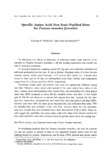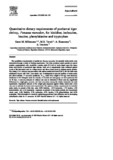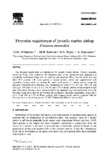Specific amino acid-free semi-purified diets for Penaeus monodon juveniles
Share
Abstract
To determine the effects of deficiency of individual amino acids believed to be essential to Penaeus monodon juveniles, a 28-day feeding experiment was carried out with P. monodon postlarvae.
P. monodon postlarvae weighing around 120 mg each were randomly distributed in individual perforated one liter jars, 10 jars in 60-liter, fiberglass tanks, in a flow through seawater system, which passed through a 0.35 micron filter before use. Animals were reared in these jars for 28 days on semi-purified moist diets. Salinity and temperature ranged from 27 to 32 ppt and 26 to 28.9°C, respectively.
Percentage weight gains and survival rates were not significantly different among test diets. However, some amino acids seemed to be more critical than others in the diets. Animals given phenylalanine-free, leucine-free, and methionine-free diets gained more than 300% compared to those fed the complete amino acid diets. A low weight gain of 228.6% was observed in animals fed arginine-free diet. Animals fed the histidine-free, lysine-free, threonine-free and valine-free diets also gained less than 200%. Survival rates were 60% for those given threonine-free and isoleucine-free diets, 70% for histidine-free and complete amino acid diets, whereas those fed the phenylalanine-free, leucine-free and methionine-free diets had survival of 80 to 85%. These results suggest the possibility that some amino acids were taken from sources outside the diets and could have corne from whatever bacterial growth there was in the rearing jars.
Suggested Citation
Pascual, F. P., & Kanazawa, A. (1986). Specific amino acid-free semi-purified diets for Penaeus monodon juveniles. Memoirs of the Kagoshima University Research Center for the South Pacific , 7(2), 65-72. http://hdl.handle.net/10862/1194
Subject
Taxonomic term
Collections
- AQD Journal Articles [1248]
Related items
Showing items related by title, author, creator and subject.
-
Variation in the biochemical composition of Penaeus monodon tissues during the reproductive cycle.
Dy-Peñaflorida, Veronica; Millamena, Oseni M. (Bamidgeh, 1990)The gonadosomatic index (GSI) and the hepatosomatic index (HSI) were determined for wild-caught, eyestalk ablated Penaeus monodon at 5 reproductive stages (I to V). Tissues of the muscle, ovary and hepatopancreas in each ... -
Quantitative dietary requirements of postlarval tiger shrimp, Penaeus monodon, for histidine, isoleucine, leucine, phenylalanine and tryptophan
Millamena, Oseni M.; Teruel, M. B.; Kanazawa, A.; Teshima, S. (Elsevier, 1999)The quantitative requirements of postlarvae Penaeus monodon for essential amino acids were determined through a series of feeding experiments. Test diets contained casein–gelatin as natural proteins supplemented with ... -
Threonine requirement of juvenile marine shrimp Penaeus monodon
Millamena, Oseni M.; Bautista, Myrna N.; Reyes, Ofelia S.; Kanazawa, A. (Elsevier, 1997)The threonine requirement was determined for juvenile marine shrimp. Penaeus monodon postlarvae, PL20, were stocked in 30-1 fiberglass tanks at ten shrimp per tank arranged in a completely randomized design with six ...




